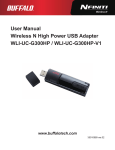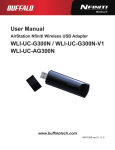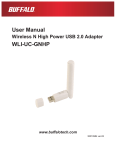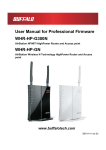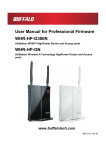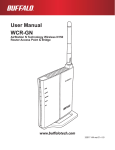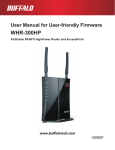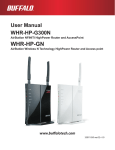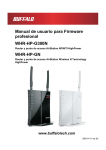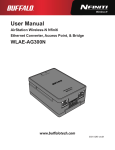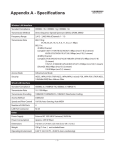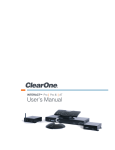Download Buffalo WLI-UC-GNM
Transcript
User Manual Wireless N150 COMPACT USB 2.0 Adapter WLI-UC-GNM www.buffalotech.com 35011405 ver.02 Contents Chapter 1 - Product Overview.......................................... 4 Features................................................................................... 4 150 Mbps High Speed Mode.................................................... 4 System Requirements.............................................................. 5 Package Contents.................................................................... 5 Hardware Overview.................................................................. 5 Chapter 2 - Installation......................................................6 Installing Wireless Drivers........................................................ 6 Installing Client Manager.......................................................... 10 Chapter 3 - Connect to a Wireless Network.................... 13 Automatic Secure Setup (AOSS/WPS).................................... 13 Windows 7 or Vista (Client Manager V).......................................... 14 Windows XP (Client Manager 3)..................................................... 15 Automatic Secure Setup (WPS PIN)........................................ 16 Windows 7 or Vista (Client Manager V).......................................... 16 Windows XP (Client Manager 3)..................................................... 20 Manual Setup (Client Manager)............................................... 22 Windows 7 or Vista (Client Manager V).......................................... 22 Windows XP (Client Manager 3)..................................................... 25 Windows Vista (WLAN AutoConfig)................................................ 27 Windows XP (Wireless Zero Configuration).................................... 30 WLI-UC-GNM User Manual 1 Chapter 4 - Client Manager............................................... 31 Software Overview................................................................... 31 Using Client Manager V with Windows 7 and Vista................. 31 Main Screen.................................................................................... 32 Automatic Secure Setup and Advanced Setup............................... 33 SSID / WPS-PIN selection.............................................................. 34 Searching Wireless Access Points.................................................. 35 Wireless Network Information......................................................... 36 WPS-PBC / AOSS selection........................................................... 37 Wireless Status............................................................................... 38 Wireless LAN Diagnostic................................................................ 40 Profile List....................................................................................... 41 Wireless Properties......................................................................... 42 Network Properties......................................................................... 43 Browser Properties......................................................................... 44 Printer Properties............................................................................ 45 Using Client Manager 3 with Windows XP............................... 46 Status.............................................................................................. 47 Scan................................................................................................ 49 Connect........................................................................................... 50 Profiles............................................................................................ 51 Profile Information (Basic)............................................................... 52 Profile Information (Network).......................................................... 54 Profile Information (Browser).......................................................... 55 Profile Information (Printers)........................................................... 56 System Tray Menu.......................................................................... 57 Option Menu................................................................................... 58 WLI-UC-GNM User Manual 2 Chapter 5 - Troubleshooting Common Problems........... 60 The Computer does not recognize the Wireless Adapter......... 60 Cannot connect to the network wirelessly................................ 60 You forgot the AP's SSID, Encryption KEY, or Password......... 60 The link speed is slower than 150 Mbps.................................. 61 Other Tips................................................................................. 61 Appendix . .................................................................... 64 150 Mbps Mode settings.......................................................... 64 Specifications........................................................................... 65 Uninstalling the Software......................................................... 66 Uninstalling the Drivers............................................................ 66 TCP/IP Settings in Windows.................................................... 67 Windows 7...................................................................................... 67 Windows Vista................................................................................ 68 Windows XP.................................................................................... 69 Compliance Information........................................................... 70 Environmental Information....................................................... 77 Warranty Information................................................................ 78 Contact Information (USA / Canada)........................................ 79 Contact Information (Europe)................................................... 80 WLI-UC-GNM User Manual 3 Chapter 1 - Product Overview Features With support for current Wireless-N, Wireless-G, and Wireless-B standards, the AirStation wireless client can transfer data to and from all standard 2.4 GHz wireless network devices. This device includes support for AOSS (AirStation One-touch Secure System) and WPS (Wi-Fi Protected Setup), making connection with other wireless devices easier. AirStation is equipped with following security features. • WPA-PSK (TKIP/AES) • WPA2-PSK (TKIP/AES) • WEP (128/64bit) 150 Mbps High Speed Mode 150 Mbps is the link speed when using 2 channel Wireless-N mode. It represents actual wireless data speeds, including overhead. Because the overhead is not available for user data transfer, usable wireless throughput will be substantially slower. WLI-UC-GNM User Manual 4 Chapter 1 Product Overview System Requirements Computer should be IBM/PC compatible (OADG specification) with a USB 2.0 port and a CD-ROM drive. * *This product does not support computers equipped with dual processors (computers with two physical CPUs). Computers with dual core CPUs are supported. *AirStation does not support Windows’ standby mode. Compatible OS: Windows 7 (32 bit / 64 bit), Vista (32 bit / 64 bit), XP (32 bit)* *Service Pack 2 or later is required for Windows XP. Package Contents The following items are included with your AirStation. If any of the items are missing, please contact your vender. • WLI-UC-GNM.................................................................................................................................. 1 • Air Navigator CD............................................................................................................................ 1 • Quick Setup Guide....................................................................................................................... 1 Hardware Overview ACT LED Flashes when sending or receiving data WLI-UC-GNM User Manual 5 Chapter 2 - Installation Installing Wireless Drivers Follow the instruction below to install drivers. Do not connect the unit to your computer yet. 1 Boot your computer and insert AirNavigator CD. The AirNavigator Setup Wizard will launch automatically. Note: If the AirNavigator Setup Wizard doesn’t launch, double click [My Computer] > CD-ROM drive icon > [AirNavi.exe] to launch manually. 2 Click [Begin Installation]. 3 Click [AirStation Wireless LAN Adapters]. WLI-UC-GNM User Manual 6 Chapter 2 Installation 4 Disable any firewalls, and click [Next]. 5 Click [Install]. 6 WLI-UC-GNM User Manual Note: • If you insert the check mark into the check box for Install Wireless Client Manager, you can install Client Manager as well as drivers. • Refer to the instructions on page 10 to install Client Manager after installing drivers. Click [Next]. 7 Chapter 2 Installation 7 Read the license agreement, select [Agree], then click [Next]. 8 When the screen to the left is displayed, put a check mark next to “Always trust software from BUFFALO INC.”, and click [Install]. 9 When the screen to the left is displayed, attach the AirStation to your computer. Drivers will be installed automatically. WLI-UC-GNM User Manual 8 Chapter 2 Installation 10 Click [OK]. 11 After the drivers are installed, the screen at left will be displayed. Click [Finish]. Note: If you checked the box to Install Wireless Client Manager (page 10), then the installation screen for Client Manager will be displayed after this screen. Follow the instructions on the screen to install Client Manager. Drivers are now installed. WLI-UC-GNM User Manual 9 Chapter 2 Installation Installing Client Manager Follow the procedure below to install Client Manager. 1 Boot your computer and insert the AirNavigator CD. The AirNavigator Setup Wizard will launch automatically. Note: If AirNavigator Setup Wizard is not displayed, double click [My Computer] icon > CD-ROM drive icon > [AirNavi.exe]. 2 Click [Options]. 3 Click [Advanced Installation]. WLI-UC-GNM User Manual 10 Chapter 2 Installation 4 Check the box for [Install Wireless Client Manager] and click [Install]. Note: Use Client Manager V with Windows Vista or Client Manager 3 with Windows XP. 5 Click [Next]. 6 Read the license agreement and select [Agree]. WLI-UC-GNM User Manual 11 Chapter 2 Installation 7 Click [Next]. 8 Click [OK]. 9 Click [Back]. 10 Click [X] at the top right corner of the window to close it. Client Manager is now installed. WLI-UC-GNM User Manual 12 Chapter 3 - Connect to a Wireless Network Automatic Secure Setup (AOSS/WPS) AOSS and WPS are systems which enable you to automatically configure wireless LAN settings. Just pressing the buttons will connect your wireless devices securely. Use these systems to connect to computers, game machines, or any wireless devices which support AOSS or WPS. AOSS (AirStation One-Touch Secure System) is technology developed by Buffalo Technology. WPS was created by the Wi-Fi Alliance. Internet őŖŔʼn őŖŔʼn ÅÒ ÐÏ× ÓÅà ÕÒÉ ÔÙ ÒÅÌ ÅÓÓ ×ÅÉ ÔÅÒ ÒÏÕ Ç ÄÉÁ Modem AirStation PC or Game console (AOSS Devices) Before using AOSS or WPS, install Client Manager software from the CD. See chapter 2 for instructions on installing Client Manager software. WLI-UC-GNM User Manual 13 Chapter 3 Connect to a Wireless Network Windows 7 or Vista (Client Manager V) If you are using Windows 7 or Vista, use the included Client Manager V software to connect wirelessly with AOSS or WPS. 1 Click [Start] > [All Programs] > [BUFFALO] > [AirStation Utility] > [Client Manager V]. 2 3 Click [Create Profile]. The User Account Control screen is displayed. Click [Yes] or [Continue]. 4 Click the [WPS AOSS] button. When "Connection has been Completed" is displayed in Client Manager V, your connection is complete. If “Set Network Location” is displayed, select “Home”, “Work”, or “Public location” depending on the environment in which the AirStation will be used. WLI-UC-GNM User Manual 14 Chapter 3 Connect to a Wireless Network Windows XP (Client Manager 3) If you are using Windows XP, use the included Client Manager 3 software to connect wirelessly with AOSS or WPS. 1 Right-click the icon in the system tray and select [Profile]. 2 Click the [WPS AOSS] button. Your connection is complete when the message "Security setup and connection have been completed" is displayed. WLI-UC-GNM User Manual 15 Chapter 3 Connect to a Wireless Network Automatic Secure Setup (WPS PIN) WPS can use a PIN generated by the Client Manager utility to easily connect to an access point that supports WPS PIN. To use WPS PIN, first install Client Manager software on your computer. See chapter 2 for instructions on installing Buffalo Client Manager software. Windows 7 or Vista (Client Manager V) If you are using Windows 7 or Vista, use your Client Manager V software to connect wirelessly with WPS PIN. 1 Click [Start] > [All Programs] > [BUFFALO] > [AirStation Utility] > [Client Manager V]. 2 3 Click [Create Profile]. The User Account Control screen is displayed. Click [Yes] or [Continue]. WLI-UC-GNM User Manual 16 Chapter 3 Connect to a Wireless Network 4 Click the [Advanced Setup] button. 5 Click the [WPS-PIN] button. WLI-UC-GNM User Manual 17 Chapter 3 Connect to a Wireless Network 6 Carefully copy the PIN code to a piece of paper, then click [Next]. 7 Select the access point to connect to, then click [Next]. This screen will be displayed. WLI-UC-GNM User Manual 18 Chapter 3 Connect to a Wireless Network 8 Use a PC with a wired Ethernet connection to log in to the access point’s management utility. Note: If the access point you are trying to connect is a Buffalo AirStation, click Wireless Config > WPS from the home page of the configuration interface. The screen to enter the PIN code will be displayed. 9 Navigate to the WPS PIN configuration screen, then enter the PIN code you write down in step 6. Note: If the access point you are trying to connect is a Buffalo AirStation, enter the PIN code in [Enrollee PIN] and click [OK]. When "Connection has been Completed" is displayed in Client Manager V, your connection is complete. If “Set Network Location” is displayed, select “Home”, “Work”, or “Public location” depending on the environment in which the AirStation will be used. WLI-UC-GNM User Manual 19 Chapter 3 Connect to a Wireless Network Windows XP (Client Manager 3) If you are using Windows XP, use your Client Manager 3 software to connect wirelessly with WPS PIN. 1 Right click on the type]. icon in the system tray and select [Easy Connection] > [WPS PIN Code 2 When the PIN code is displayed, write it down. Then, click [Next]. 3 Select the access point you are going to connect to, then click [Next]. WLI-UC-GNM User Manual 20 Chapter 3 Connect to a Wireless Network This screen will be displayed. 4 Use a computer with a wired Ethernet connection to log in to the access point. The screen to enter the PIN code will be displayed. Note: If the access point you are trying to connect is a Buffalo AirStation, click Wireless Config > WPS from the home page configuration interface. The screen to enter the PIN code will be displayed. 5 On the configuration screen of the access point, enter the PIN code you wrote down in step 2. Note: If the access point you are trying to connect is a Buffalo AirStation, enter the PIN code in [Enrollee PIN] and click [OK]. Your connection is complete when the message "Security setup and connection have been completed" is displayed. WLI-UC-GNM User Manual 21 Chapter 3 Connect to a Wireless Network Manual Setup (Client Manager) You may also connect to an access point manually, without using AOSS or WPS. The procedure varies depending on the version of Windows used. First, install Client Manager from the included CD. See chapter 2 for instructions on installing Client Manager. Windows 7 or Vista (Client Manager V) With Windows 7 or Vista, use Client Manager V to connect wirelessly. 1 Click [Start] > [All Programs] > [BUFFALO] > [AirStation Utility] > [Client Manager V]. 2 3 Click [Create Profile]. The User Account Control screen is displayed. Click [Yes] or [Continue]. WLI-UC-GNM User Manual 22 Chapter 3 Connect to a Wireless Network 4 Click the [Advanced Setup] button. 5 WLI-UC-GNM User Manual Click the [Connect Manually] button. 23 Chapter 3 Connect to a Wireless Network 6 Select your access point, then click [Next]. 7 Enter your Network Type, Security Type, Encryption Method, and Encryption Key (passphrase), then click [Connect]. When "Connection has been completed" is displayed, your connection is complete. If “Set Network Location” is displayed, select “Home”, “Work”, or “Public location”, depending on the environment in which the AirStation will be used. WLI-UC-GNM User Manual 24 Chapter 3 Connect to a Wireless Network Windows XP (Client Manager 3) Client Manager 3 is a wireless connection utility for Windows XP. 1 Right click on the icon in the system tray, then select [Scan]. 2 Select the access point to connect to and click [Next]. 3 Choose your Encryption Method and enter an Encryption Key. Click [Connect]. Follow the instructions on the screen to connect. WLI-UC-GNM User Manual 25 Chapter 3 Connect to a Wireless Network Manual Setup (Windows Utility) You can connect to an access point without installing or using Client Manager. Windows includes a built-in wireless utility. The procedure varies depending on the version of Windows used. Windows 7 (WLAN AutoConfig) With Windows 7, use WLAN AutoConfig to connect to the AirStation. 1 Click on the network icon in the system tray. 2 Select the target AirStation’s name and click [Connect]. If you will be connecting to this device in the future, checking [Connect automatically] is recommended. 3 Enter the encryption key and click [OK]. Follow the instructions on the screen to connect. WLI-UC-GNM User Manual 26 Chapter 3 Connect to a Wireless Network Windows Vista (WLAN AutoConfig) You can use WLAN AutoConfig to connect to a wireless Access Point: 1 Right click on the 2 Click [Connect to a network]. 3 WLI-UC-GNM User Manual network icon in the system tray. Select your wireless network and click [Connect]. 27 Chapter 3 Connect to a Wireless Network If the screen below is displayed, click [I want to enter the network key or passphrase instead]. Go to step 4. WLI-UC-GNM User Manual 28 Chapter 3 Connect to a Wireless Network 4 Enter the encryption key and click [Connect]. Step through the wizard to complete configuration. If the “Set Network Location” screen is displayed, select “Home”, “Work”, or “Public location“ depending where you’re using the AirStation. WLI-UC-GNM User Manual 29 Chapter 3 Connect to a Wireless Network Windows XP (Wireless Zero Configuration) Windows XP includes a built-in utility to connect to your wireless access point. Note: If Client Manager 3 is installed on your computer, then Wireles Zero Configuration is disabled. Uninstall Client Manager 3 to use Wireless Zero Configuration, or just use Client Manager 3 to connect to the AirStation. 1 Right click on the wireless network icon 2 Click [View Available Wireless Networks]. in the system tray. 3 Select a wireless network, then click [Connect]. 4 Enter the encryption key (passphrase) twice, then click [Connect]. When the connection is complete, the word “Connected” will be displayed to the right of the network’s SSID. Click the “X” in the top right corner of the window to close the utility. WLI-UC-GNM User Manual 30 Chapter 4 - Client Manager Software Overview Client Manager is utility software used to connect to an access point on the network or to verify the connection between an access point and your computer. It is included with your AirStation. Note: Two versions of Client Manager are included on your AirNavigator CD. Client Manager V supports Windows 7 and Vista. Client Manager 3 supports Windows XP. The installation program will install the correct version for your operating system. Using Client Manager V with Windows 7 and Vista • When you install Client Manager, it will be added to your Startup folder and will automatically launch with Windows. If Client Manager does not launch automatically, click [Start] > [All Programs ]> [BUFFALO] > [AirStation Utility] > [ClientManager V] to launch it. • To close Client Manager, right-click on its icon in the system tray and choose [Exit]. • The appearance of the Client Manager icon varies according to its connection status: : No wireless connection. Communicating via an access point. WLI-UC-GNM User Manual 31 Chapter 4 Client Manager Main Screen The Main screen displays the current connection status. You can perform the following operations from this screen. Parameter Meaning Profile Displays information about the current connection points. If you have multiple connection points, you can switch among them. Transmission Speed Displays the current connection speed. Signal Strength Displays the current signal strength. Create Profile Click this to display the Automatic Secure Setup and Advanced Setup screen (next page). Advanced Click this to display the Wireless Status screen. WLI-UC-GNM User Manual 32 Chapter 4 Client Manager Automatic Secure Setup and Advanced Setup There are two ways to connect to an access point: automatic or manual. In the following wizard, automatic setup will be referred to as “AOSS/WPS” and manual setup will be referred to as “Advanced Setup”. Parameter Meaning Wireless Adapter Displays the names of currently used wireless devices. Automatic Secure Setup Clicking this will search for an AOSS or WPS compatable access point to connect to automatically. Advanced Setup Click this to display the SSID/WPS-PIN selection screen (next page). Option (Expert only) Click this to specify whether you use AOSS or WPS (PBC) for connection in Automatic Secure Setup. It displays the WPS-PBC/ AOSS selection screen. WLI-UC-GNM User Manual 33 Chapter 4 Client Manager SSID / WPS-PIN selection This screen lets you select whether to connect to an access point by specifying the SSID or by enterring a WPS PIN. Parameter Meaning Connect Manually Displays the “Searching Wireless Access Points” screen and lets you enter connection settings manually. Connect with WPS-PIN Click this to connect to a wireless access point by entering its WPS PIN. WLI-UC-GNM User Manual 34 Chapter 4 Client Manager Searching Wireless Access Points This screen lists available wireless access points in your area. You can select an access point and enter network information manually to connect. Parameter Meaning Network Name (SSID) Displays the SSID of each available access point. Security Displays whether or not the access point uses encryption. Channel Displays the wireless channel used by an access point. Strength Displays the signal strength of an access point. Enter the Network Name (SSID) manually Click this to display the Wireless Network Information screen, where you can enter an SSID manually. [Search] Click here to search for available access points again. [Next] Click this to display the Wireless Network Information screen. WLI-UC-GNM User Manual 35 Chapter 4 Client Manager Wireless Network Information Configure wireless connection settings. Parameter Meaning Network Type Select a type of connection. Network Name (SSID) Enter the SSID of an access point. Security Type Select the security type of the selected access point. Encryption Method Select the encryption method of the selected access point. Encryption Key or Passphrase Enter the encryption key for the access point. Connect to a network which does not Check this box to connect to a hidden SSID that is not broadcast. broadcast the SSID Connect WLI-UC-GNM User Manual Connect to the access point. 36 Chapter 4 Client Manager WPS-PBC / AOSS selection You may automatically connect to an access point by just pushing or clicking two buttons with WPS or AOSS. Parameter Meaning Automatic Secure Setup WPS-PBC method Click this to automatically connect to an access point that supports WPS. Automatic Secure Setup AOSS method Click this to automatically connect to an access point that supports AOSS. WLI-UC-GNM User Manual 37 Chapter 4 Client Manager Wireless Status This screen displays the current connection status. Parameter Meaning Adapter Displays the name of the current wireless client. Execute wireless LAN diagnostics Opens the Wireless LAN Diagnostics wizard. Profile Name Displays the current profile name. Status Displays the current transmission status. Network Mode Displays the current network mode. Transmission Speed Displays the current transmission speed. SSID Displays the SSID of the currently connected access point. Channel Displays the wireless channel currently used. WLI-UC-GNM User Manual 38 Chapter 4 Client Manager Parameter Meaning Security Displays whether encryption is currently enabled or not. Authentication Type Displays the type of authenticaltion currently used. Encryption Type Displays the type of encryption currently used. Signal Strength Displays the current signal strength. IP Address Displays the IP address assigned to your wireless client. Subnet Mask Displays the subnet mask assigned to your wireless client. Default Gateway Displays the default gateway address. Primary DNS Displays the primary DNS address. Secondary DNS Displays the secondary DNS address. MAC Address Displays the MAC address of your wireless client. WLI-UC-GNM User Manual 39 Chapter 4 Client Manager Wireless LAN Diagnostic On the Wireless LAN Diagnostic screen, you can check signal strength and quality. Parameter Meaning Adapter Displays the name of the wireless client currently in use. Connection status Displays signal strength (dBm), link rate (Mbps), and signal quality (%) at 1 minute intervals. Possible restrictions: • Some wireless devices may not be displayed. • Signal strength and quality displays may vary. These graphs should not be used to compare different wireless devices. Only use them to compare information for the same wireless device. Usage of each channel The 11b/11g displays usage of each channel on 2.4 GHz. This unit does not display 11a usage, as it does not support 5 GHz. The color expresses the signal strength of an access point. Redder means a stronger signal, bluer means a weaker signal. WLI-UC-GNM User Manual 40 Chapter 4 Client Manager Profile List Create a new profile or edit an existing profile. Parameter Meaning Adapter Displays the name of the current wireless client. New Create a new profile. This displays the Automatic Secure Setup and Advanced Setup screen. Edit Edit the selected profile. This displays the Extended properties (Wireless) screen. Delete Delete the selected profile. Down Lower the priority of the selected profile. Up Raise the priority of the selected profile. WLI-UC-GNM User Manual 41 Chapter 4 Client Manager Wireless Properties Current wireless settings. Parameter Meaning Connection Displays the current profile name. SSID Displays the SSID of the current connection. Security Type Displays the security type you are using for the current connection. Encryption Type Displays the encryption type you are using for the current connection. Security key or Pass phrase Displays the security key or pass phrase if [Display password visible] is checked. Connect an access point even SSID broadcasting is disabled. Check to connect to a wireless network that doesn’t broadcast its SSID. WLI-UC-GNM User Manual 42 Chapter 4 Client Manager Network Properties By default, your client’s IP address is set automatically by DHCP. You may configure it manually from this screen. Parameter Meaning Do not change IP Address settings of this Profile Select to keep your current TCP/IP network setting without any changes. This is the recommended setting. Use the following settings Select this option to change your TCP/IP network settings. For expert users only. WLI-UC-GNM User Manual 43 Chapter 4 Client Manager Browser Properties Configure Internet Explorer settings for wireless connections. Parameter Meaning Do not change the browser settings Select to keep the current Internet Explorer settings. of this Profile Use the following settings Select this option to use different Internet Explorer Home Page and Proxy Server settings while connected wirelessly. WLI-UC-GNM User Manual 44 Chapter 4 Client Manager Printer Properties Configure the printer used while connected to an access point wirelessly. Parameter Meaning Do not change the printer settings of Select to keep your current printer settings. this Profile Use the following settings WLI-UC-GNM User Manual Select to use a different default printer while connected wirelessly. 45 Chapter 4 Client Manager Using Client Manager 3 with Windows XP • When you install Client Manager, it will be added to your Startup folder and will automatically start with Windows. To launch Client Manager manually, click [Start] > [All Programs] > [BUFFALO] > [AirStation Utility] > [ClientManager3]. • Right click on the Client Manager icon in the system tray and click [Exit] to close Client Manager. The Client Manager icon will change appearance according to its connection status: : No wireless client installed : Not connected to an access point : Transmitting to an access point with TKIP/AES encryption : Transmitting to an access point with WEP, or not encrypted : Transmitting in ad-hoc mode (not supported with this wireless client) : Authenticating WLI-UC-GNM User Manual 46 Chapter 4 Client Manager Status The Status screen displays the status of the current connection. Parameter Meaning Profile Current connection profile name. SSID SSID of the currently connected access point. Adapter Name Name of the wireless client currently in use. Network Type Current network mode. Transmission Speed Current transmission speed. Channel Current wireless channel. Security Displays whether security is currently enabled or not. IP Address The IP address assigned to this unit. WLI-UC-GNM User Manual 47 Chapter 4 Client Manager Parameter Meaning MAC Address MAC address of this unit. Duration Elapsed duration of the current wireless connection. Signal Strength Current signal strength. Reconnect Click to reconnect to the most recent connection. WLI-UC-GNM User Manual 48 Chapter 4 Client Manager Scan Scan and display nearby access points. Parameter Meaning SSID SSID of access point. Wireless mode Type of access point (11a or 11g). Channel Wireless channel of the access point. Strength Reception strength of each access point. Encryption Lock symbol is shown if the access point uses encryption. Connect Click to display the Connect page. Refresh Click to refresh the list of available access points. WLI-UC-GNM User Manual 49 Chapter 4 Client Manager Connect Configure connection to an access point. Parameter Meaning Encryption Method Type of encryption used by the access point. Encryption Key Enter one or more encryption keys. Register Profile Check to register this connection as a profile. WLI-UC-GNM User Manual 50 Chapter 4 Client Manager Profiles Connect to an access point or edit a profile. Parameter Meaning Connect Selecting a profile and clicking this button will connect to an access point using its stored profile information. Add Click to add a new profile. Edit Click to edit or delete information in a profile. WPS AOSS Click to have AOSS/WPS (PBC) automatically set security. After connection, a profile based on these settings will be created. 802.1x Profiles This button is displayed when Client Manager is operating in Business Mode. Click to configure 802.1x authentication. WLI-UC-GNM User Manual 51 Chapter 4 Client Manager Profile Information (Basic) Configure your profile settings. Parameter Meaning Display Icon Select an icon to display for this profile. Select Profile Connection may be wireless or wired (Ethernet). For use with the AirStation, select Wireless. Profile Name Enter a name for the profile. Network Type Select infrastructure mode to connect to an access point (recommended), or ad-hoc mode to connect directly to another wireless client. SSID Select the SSID of the wireless access point that the profile will connect to. Channnel Choose the wireless channel. In Infrastructure Mode, the channel is automatically configured. WLI-UC-GNM User Manual 52 Chapter 4 Client Manager Parameter Meaning Encryption Method Select the encryption method used by the wireless access point. Transmission Key If WEP is used for the Encryption Method, up to 4 passphrases may be entered. Choose the number of passphrases. Encryption Key Enter the encryption key(s) for the access point. AP is set to exclusive connection Check if the access point’s SSID is not broadcast. WLI-UC-GNM User Manual 53 Chapter 4 Client Manager Profile Information (Network) The profile’s IP address and subnet mask may be manually assigned. Parameter Meaning Do not change IP Address settings of this Profile Check to keep using current TCP/IP network settings. Automatically acquire the IP Address Check to automatically acquire the IP address from a DHCP server when connecting wirelessly. Automatically acquire the DNS Server Check to automatically aquire the DNS server address from a DHCP Address server when connecting wirelessly. WLI-UC-GNM User Manual 54 Chapter 4 Client Manager Profile Information (Browser) Configure your Internet Explorer settings when connecting wirelessly. Parameter Meaning Do not change the browser settings of this Profile Check to use current Internet Explorer settings when connecting wirelessly. Uncheck to use any of the settings below. Address to use as Home Page To use a different home page in Internet Explorer when connecting wirelessly, enter it here. Use the Proxy Server To use a proxy server for Internet Explorer when connecting wirelessly, enter its IP address and a port number and check the box. Do not use the proxy server for a local If checked, the proxy server will not be used for local addresses. address WLI-UC-GNM User Manual 55 Chapter 4 Client Manager Profile Information (Printers) Configure the printer that your computer uses when connected wirelessly. Parameter Meaning Do not change the printer settings of this Profile Select this option to use a different printer when connecting wirelessly. WLI-UC-GNM User Manual 56 Chapter 4 Client Manager System Tray Menu Right-click on the Client Manager icon in the system tray to display the following choices. Parameter Meaning Status Displays the Status screen. Scan Displays the Scan screen. Profile Displays the Profiles screen. Easy Connection Runs Automatic Secure Setup, using one of the following connection methods: AOSS, WPS(PBC), or WPS(PIN). Help Displays Client Manager Help. Option Displays the Options menu screen. Version Information Displays Client Manager version information. Exit Exits Client Manager. WLI-UC-GNM User Manual 57 Chapter 4 Client Manager Option Menu Configure Client Manager options. Parameter Meaning Mode Switch between Client Manager’s operating modes. If you select [Business Mode], the button to configure 802.1x authentication appears on the Profiles screen. [Home Mode] is recommended for most users. Lock If you click this, a password will be required to add new profiles or edit existing profiles. To lock or unlock, enter the password (8 - 63 characters). Export a profile Click this to save the currently registered profile information. To save profile information, enter the password ( 8 - 63 characters). Import a profile Click this to import a saved profile into Client Manager. You’ll need to enter the password for the profile to continue. WLI-UC-GNM User Manual 58 Chapter 4 Client Manager Parameter Meaning Initialize profile Click this to initialize profile information. Before initializing profile information, unlock the unit. Use the following network adapter Select a network adaptor to use in Client Manager. [Wireless Adapter Auto-select] is recommended for most users. Automatically connect to the profile with highest priority If checked, it will attempt to connect to the profile with highest priority as assigned on the Profile screen (page 51). Checked is recommended for most users. WLI-UC-GNM User Manual 59 Chapter 5 - Troubleshooting Common Problems The Computer does not recognize the Wireless Adapter. • Make sure the wireless adapter is connected to a USB port on your computer. • If your computer has multiple USB ports, try connectting to a different USB port. • Refer to Chapter 2 to reinstall drivers for this unit. Cannot connect to the network wirelessly. • Refer to chapter 3 for several different ways to connect this unit to an access point wirelessly. • Configure the same SSID, encryption method, and encryption key for each wireless device. These settings must match those of your wireless access point. • Move your wireless devices closer to the access point. • Restart your access point. You forgot the AP's SSID, Encryption KEY, or Password. • Ask your network administrator about your SSID and encryption settings. These settings must match the SSID and encryption settings of the access point. • If your access point supports AOSS or WPS, try using them to connect to the access point. Instructions for connecting with AOSS or WPS are in chapter 3. WLI-UC-GNM User Manual 60 Chapter 5 Troubleshooting Common Problems The link speed is slower than 150 Mbps. The default setting for 150 Mbps mode on the AirStation is off. Refer to "150 Mbps Mode settings" in page 64 to turn on 150 Mbps mode. Other Tips Issue: When using the Windows wireless connection manager, I cannot connect to my wireless router. I receive a "Cannot configure wireless network" error message when scanning for available wireless networks. Answer: Another wireless client software may be installed on your computer that is taking control of the wireless client adapter away from the Windows connection manager. Either switch to the other software or use Add/Remove Programs to remove the conflicting client software. Then the Windows connection manager should be able to connect to any available wireless networks. Issue: When I attempt to connect to my wireless router, I receive an error message indicating that security settings on my computer do not match the settings on the router. Answer: Manually enter the correct security key and encryption type into the Windows connection manager. To enter the security key in Windows XP: Go to Wireless Networks Connection Status and click on View Wireless Networks. There will be a list of networks to which you have previously connected. Highlight the network name (SSID) of the wireless router and click on Connect. Enter the correct encryption key and click on Connect. WLI-UC-GNM User Manual 61 Chapter 5 Troubleshooting Common Problems Issue: What can I do if my wireless connection drops randomly or seems slow? Answer: There are many environmental factors that may affect this behavior. First, ensure the issue is not range related by moving the access point and the wireless client closer together. Check whether the connection drops continue. In some cases, interference from other wireless networks or sources such as 2.4 GHz wireless phones may impact performance. Try changing the wireless channel used by your wireless router. Log in to the wireless router with your browser. Click on the [Wireless Configuration]. If an AutoChannel option is available, use it. Otherwise, manually select an alternate channel. Issue: Though I am able to successfully make a connection with my wireless router, I am unable to access the Internet with my web browser. Answer: First, power off the Cable or DSL modem, the wireless router, and then your computer. Pressing the power button or simply unplugging the devices can power off the modem and wireless router devices. Then after verifying that the modem is connected to the wireless router with a cable to the WAN port, power on the modem and wait two minutes. Turn on the wireless router and then the computer. Verify whether an Internet connection is available. If, after these steps, an Internet connection is still unavailable, power off the Cable or DSL modem and computer again and directly connect your computer to the Cable or DSL modem with a cable between the computer and the port on the modem. Power on the modem and wait two minutes. Power on the computer and again check for an Internet connection. If an Internet connection is not available with a direct connection to the computer, please call the Internet Service Provider who installed the modem. If an Internet connection is available with a direct connection to the computer, please call our customer support line. WLI-UC-GNM User Manual 62 Chapter 5 Troubleshooting Common Problems Issue: Where can I download the latest drivers, firmware and instructions for my Buffalo wireless products? Answer: The latest drivers and firmware with installation instructions are available online at www.buffalotech.com WLI-UC-GNM User Manual 63 Appendix 150 Mbps Mode settings By default, the AirStation’s 150 Mbps mode is disabled. To enable it: 1. Click [Start] > [All Programs] > [BUFFALO] > [AirStation Utility] > [AirStation Bandwidth 20 or 40MHz Select Tool] and launch the utility software. If you are using Windows 7 or Vista and see the message "A program needs your permission to continue", click [Yes] or [Continue]. 2. When the message "Now start the setup wizard of Bandwidth Select Tool" is displayed, click [Next]. 3. Click [Next]. 4. When the message "Select wireless adapter" appears, select this unit and click [Next]. 5. Select [Use 150Mbps Mode (40MHz)], and click [Next]. 6. When the message "Wireless adapter setting is completed" is displayed, click [Exit to setup]. If you still cannot establish a 150 Mbps connection, check the settings for your access point. WLI-UC-GNM User Manual 64 Appendix Specifications Wireless LAN Interface Standard Compliance IEEE802.11b / IEEE802.11g / IEEE802.11n Transmission Method Direct Sequence Spread Spectrum (DSSS), OFDM, SISO Frequency Range 2,412 - 2,462 MHz (Channels 1 - 11) Transmission Rate 802.11b/g: 54, 48, 36, 24, 18, 12, 9, 6, 11, 5.5, 2, 1 Mbps 802.11n 20 MHz BW (Long GI) 65, 58.5, 52, 39, 26, 19.5, 13, 6.5 Mbps (1 stream) (Short GI)72.2, 65, 57.8, 43.3, 28.9, 21.7, 14.4, 7.2 Mbps (1 stream) 40 MHz BW (Long GI) 135, 121.5, 108, 81, 54, 40.5, 27, 13.5 Mbps (1 stream) (Short GI)150, 135, 120, 90, 60, 45, 30, 15 Mbps (1 stream) Access Mode Infrastructure Mode, Adhoc Mode Security WPA2-PSK (TKIP/AES), WPA-PSK (TKIP/AES), 128/64bit WEP Other Power Supply 5.0 V Bus-powered Power Consumption 2500 mW (Max) Dimensions 15 mm x 8 mm x 20 mm (0.59 x 0.31 x 0.79 in.) Weight 3 g (~0.1 ounces) Operating Environment 0 - 40° C (32 - 104° F) , 20 - 80% (non-condensing) WLI-UC-GNM User Manual 65 Appendix Uninstalling the Software To uninstall the software, follow the procedure described below. 1. Insert AirNavigator CD. When you insert CD, AirNavigator Setup Wizard will launch automatically. To launch it manually, double click [My Computer], then your CD-ROM, then [AirNavi.exe]. 2. Click [Options]. 3. Click [Uninstall software]. 4. Step through the wizard to uninstall the software. Uninstalling the Drivers To remove the AirStation wireless client drivers, follow the procedure described below. 1. Insert your AirNavigator CD. When you insert CD, AirNavigator Setup Wizard will launch automatically. To launch it manually, double click [My Computer], then your CD-ROM, then [AirNavi.exe]. 2. Click [Options]. 3. Click [Remove Drivers]. 4. Follow the instructions on the screen to remove drivers. WLI-UC-GNM User Manual 66 Appendix TCP/IP Settings in Windows Windows 7 To configure TCP/IP in Windows 7, follow the procedure below. 1 Click [Start] > [Control Panel] > [Network and Internet]. 2 Click [Network and Sharing Center]. 3 Click [Change Adapter Settings] on the left side menu. 4 Right click on [Local Area Connection], then click [Properties]. 5 If the message “Windows needs your permission to continue” appears, click [Continue]. 6 Select [Internet Protocol Version 4 (TCP/IPv4)] then click [Properties]. 7 To have DHCP set your IP address settings automatically, check [Obtain an IP address automatically] and [Obtain DNS server address automatically]. To set your IP address settings manually, enter values for each settings. Example: 8 If the router’s IP address is 192.168.11.1, IP address 192.168.11.80 Subnet mask 255.255.255.0 Default gateway 192.168.11.1 Preferred DNS server 192.168.11.1 Alternate DNS server blank Click [OK]. WLI-UC-GNM User Manual 67 Appendix Windows Vista To configure TCP/IP in Windows Vista, follow the procedure below. 1 Click [Start] > [Settings] > [Control Panel]. 2 Double click [Network and Sharing Center]. 3 Click [Manage network connections] on the left side menu. 4 Right click on [Local Area Connection], then click [Properties]. 5 When the message [Windows needs your permission to continue], click [Continue]. 6 Select [Internet Protocol Version 4 (TCP/IPv4)], then click [Properties]. 7 To have DHCP set your IP address settings automatically, check [Obtain an IP address automatically] and [Obtain DNS server address automatically]. To set your IP address settings manually, enter values for each setting. Example: 8 If the router’s IP address is 192.168.11.1, IP address 192.168.11.80 Subnet mask 255.255.255.0 Default gateway 192.168.11.1 Preferred DNS server 192.168.11.1 Alternate DNS server blank Click [Close]. WLI-UC-GNM User Manual 68 Appendix Windows XP To configure TCP/IP in Windows XP, follow the procedure below. 1 Click [Start] > [Settings] > [Control Panel]. 2 Double click [Network]. 3 Right click on [Local Area Connection], then click [Properties]. 4 Select [Internet Protocol (TCP/IP)], then click [Properties]. 5 To have DHCP set your IP address settings automatically, check [Obtain an IP address automatically] and [Obtain DNS server address automatically]. To set your IP address settings manually, enter values for each setting. Example:. 6 If the router’s IP address is 192.168.11.1, IP address 192.168.11.80 Subnet mask 255.255.255.0 Default gateway 192.168.11.1 Preferred DNS server 192.168.11.1 Alternate DNS server blank Click [Close]. WLI-UC-GNM User Manual 69 Appendix Compliance Information Federal Communication Commission Interference Statement: This equipment has been tested and found to comply with the limits for a Class B digital device, pursuant to Part 15 of the FCC Rules. These limits are designed to provide reasonable protection against harmful interference in a residential installation. This equipment generates, uses and can radiate radio frequency energy and, if not installed and used in accordance with the instructions, may cause harmful interference to radio communications. However, there is no guarantee that interference will not occur in a particular installation. If this equipment does cause harmful interference to radio or television reception, which can be determined by turning the equipment off and on, the user is encouraged to try to correct the interference by one of the following measures: • Reorient or relocate the receiving antenna. • Increase the separation between the equipment and receiver. • Connect the equipment into an outlet on a circuit different from that to which the receiver is connected. • Consult the dealer or an experienced radio/TV technician for help. FCC Caution: Any changes or modifications not expressly approved by the party responsible for compliance could void the user’s authority to operate this equipment. This device complies with Part 15 of the FCC Rules. Operation is subject to the following two conditions: (1) This device may not cause harmful interference, and (2) this device must accept any interference received, including interference that may cause undesired operation. Important Note - FCC Radiation Exposure Statement: This equipment complies with FCC radiation exposure limits set forth for an uncontrolled environment. End users must follow the specific operating instructions for satisfying RF exposure compliance. To maintain compliance with FCC RF exposure compliance requirements, please follow operation instructions as documented in this manual. This device and its antenna(s) must not be colocated or operating in conjunction with any other antenna or transmitter. SAR compliance has been established in typical laptop computers with USB slot, and product could be used in typical laptop computer with USB slot. Other applications like handheld PCs or similar devices have not been verified and may not comply with related RF exposure rule and such use shall be prohibited. The availability of some specific channels and/or operational frequency bands are country dependent and are firmware programmed at the factory to match the intended destination. This firmware setting is not accessible by the end user. WLI-UC-GNM User Manual 70 Appendix Industry Canada Statement: This device complies with RSS-210 of the Industry Canada Rules. Operation is subject to the following two conditions: (1) This device may not cause harmful interference, and (2) This device must accept any interference received, including interference that may cause undesired operation. Important Note - Radiation Exposure Statement: This equipment complies with Canada radiation exposure limits set forth for an uncontrolled environment. End users must follow the specific operating instructions for satisfying RF exposure compliance. To maintain compliance with Canada RF exposure compliance requirements, please follow operation instruction as documented in this manual. This transmitter must not be co-located or operating in conjunction with any other antenna or transmitter. CE Notification: This is a Class B product. In a domestic environment, this product may cause radio interference, in which case the user may be required to take adequate measures. Europe - EU Declaration of Conformity: This device complies with the essential requirements of the R&TTE Directive 1999/5/EC. The following test methods have been applied in order to prove presumption of conformity with the essential requirements of the R&TTE Directive 1999/5/EC. A copy of the Declaration of Conformity can be downloaded by selecting this product from the list at http://www.buffalo-technology.com/support/downloads/ • EN60950-1:2006 Safety of Information Technology Equipment • EN 62311:2008 Assessment of electronic and electrical equipment related to human exposure restrictions for electromagnetic fields (0 Hz-300 GHz). • EN 300 328 V1.7.1 (2006-10) Electromagnetic compatibility and Radio spectrum Matters (ERM); Wideband Transmission systems; Data transmission equipment operating in the 2.4 GHz ISM band and using spread spectrum modulation techniques; Harmonized EN covering essential requirements under article 3.2 of the R&TTE Directive. WLI-UC-GNM User Manual 71 Appendix • EN 301 489-1 V1.8.1: (2008-04) Electromagnetic compatibility and Radio spectrum Matters (ERM) — ElectroMagnetic Compatibility (EMC) standard for radio equipment and services — Part 1: Common technical requirements. • EN 301 489-17 V2.1.1 (2009-05) Electromagnetic compatibility and Radio spectrum Matters (ERM); ElectroMagnetic Compatibility (EMC) standard for radio equipment; Part 17: Specific conditions for Broadband Data Transmission Systems Intended use: This device is a 2.4 GHz wireless LAN transceiver, intended for indoor home and office use in all EU and EFTA member states. EU Countries intended for use This device is intended for indoor home and office use in the following countries: Austria, Belgium, Germany, Denmark, Spain, Greece, France, Finland, Italy, Ireland, Luxembourg, The Netherlands, Portugal, Sweden, United Kingdom, Cyprus, Czech Republic, Estonia, Hungry, Latvia, Lithuania, Malta, Poland, Slovak Republic and Slovenia. The device is also authorised for use in all EFTA member states Iceland, Liechtenstein, Norway and Switzerland. EU countries not intended for use: None Potential restrictive use: This device is a 2.4 GHz wideband transmission system (transceiver), intended for use in all EU member states and EFTA countries, except in France and Italy where restrictive use applies. In Italy the end-user should apply for a license at the national spectrum authorities in order to obtain an authorization to use the device for setting up outdoor radio links and/or for supplying public access to telecommunications and/or network services. In Belgium there is a restriction in outdoor use. The frequency range in which outdoor operation in Belgium is permitted is 2460 – 2483.5 MHz. This device may not be used for setting up outdoor radio links in France and in some areas the RF ourput power may be limited to 10 mW EIRP in the frequency range of 2454 - 2483.5 MHz. For detailed information the end-user should contact the national spectrum authority in France. WLI-UC-GNM User Manual 72 Appendix Taiwan: SAR compliance has been established in typical laptop computer(s) with CardBus slot, and product could be used in typical laptop computer with CardBus slot. Other application like handheld PC or similar device has not been verified, may not comply with related RF exposure rules, and such use shall be prohibited. 根據 NCC 低功率電波輻射性電機管制辦法: 第十二條: 經型式認證合格之低功率射頻電機,非經許可,公司、商號或使用者均不得擅自變更頻率、加 大功率或變更原設計之特性及功能。 第十四條: 低功率射頻電機之使用不得影響飛航安全及干擾合法通信;經發現有干擾現象時,應立即停用, 並改善至無干擾時方得繼續使用。前項合法通信,指依電信法規定作業之無線電通信。低功率 射頻電機須忍受合法通信或工業、科學及醫療用電波輻射性電機設備之干擾。 이 기기는 가정용으로 전자파적합등록을 한 기기로서 주거지역에서는 물론 모든 지역에서 사 용할 수 있습니다 . 해당 무선설비는 전파혼신 가능성이 있으므로 인명안전과 관련된 서비스는 할 수 없음 WLI-UC-GNM User Manual 73 Appendix [ United States ] Tested to comply [ Indonesia ] With FCC Standards FCC ID:FDI-09102085-0 [ Australia ] [ Korea ] 15640/POSTEL/2010 2347 [ India ] 681/2010/WRLO [ Canada ] 6102A-032 [ Kuwait ] mc/m/5/3-11176 [ Oman ] TRA/TA-R/1366-01/10 [ Philippnes ] No. : ESD-1004378C BUF-WLIUCGNM01 [ Singapore ] Complies with IDA Standards DA103412 [ UAE ] ER0043290/10 WLI-UC-GNM User Manual 74 Appendix Česky[Czech] Buffalo Technology Inc. tímto prohlašuje, že tento AirStation WLI-UC-GNM je ve shodě se základními požadavky a dalšími příslušnými ustanoveními směrnice 1999/5/ES. Dansk[Danish] Undertegnede Buffalo Technology Inc. erklærer herved, at følgende udstyr AirStation WLI-UC-GNM overholder de væsentlige krav og øvrige relevante krav i direktiv 1999/5/EF. Deutsch[German] Hiermit erklärt Buffalo Technology Inc. dass sich das Gerät AirStation WLI-UC-GNM in Übereinstimmung mit den grundlegenden Anforderungen und den übrigen einschlägigen Bestimmungen der Richtlinie 1999/5/EG befindet. Eesti[Estonian] Käesolevaga kinnitab Buffalo Technology Inc. seadme AirStation WLI-UC-GNM vastavust direktiivi 1999/5/EÜ põhinõuetele ja nimetatud direktiivist tulenevatele teistele asjakohastele sätetele. English Hereby, Buffalo Technology Inc. declares that this AirStation WLI-UC-GNM is in compliance with the essential requirements and other relevant provisions of Directive 1999/5/EC. Español[Spanish] Por medio de la presente Buffalo Technology Inc. declara que el AirStation WLI-UC-GNM cumple con los requisitos esenciales y cualesquiera otras disposiciones aplicables o exigibles de la Directiva 1999/5/CE. Ελληνική[Greek] ΜΕ ΤΗΝ ΠΑΡΟΥΣΑ Buffalo Technology Inc. ΔΗΛΩΝΕΙ ΟΤΙ AirStation WLI-UC-GNM ΣΥΜΜΟΡΦΩΝΕΤΑΙ ΠΡΟΣ ΤΙΣ ΟΥΣΙΩΔΕΙΣ ΑΠΑΙΤΗΣΕΙΣ ΚΑΙ ΤΙΣ ΛΟΙΠΕΣ ΣΧΕΤΙΚΕΣ ΔΙΑΤΑΞΕΙΣ ΤΗΣ ΟΔΗΓΙΑΣ 1999/5/ΕΚ. Français[French] Par la présente Buffalo Technology Inc. déclare que l’appareil AirStation WLI-UC-GNM est conforme aux exigences essentielles et aux autres dispositions pertinentes de la directive 1999/5/CE. Italiano[Italian] Con la presente Buffalo Technology Inc. dichiara che questo AirStation WLI-UC-GNM è conforme ai requisiti essenziali ed alle altre disposizioni pertinenti stabilite dalla direttiva 1999/5/CE. Latviski[Latvian] Ar šo Buffalo Technology Inc. deklarē, ka AirStation WLI-UC-GNM atbilst Direktīvas 1999/5/EK būtiskajām prasībām un citiem ar to saistītajiem noteikumiem. WLI-UC-GNM User Manual 75 Appendix Lietuvių[Lithuanian] Šiuo Buffalo Technology Inc. deklaruoja, kad šis AirStation WLI-UC-GNM atitinka esminius reikalavimus ir kitas 1999/5/EB Direktyvos nuostatas. Nederlands[Dutch] Hierbij verklaart Buffalo Technology Inc. dat het toestel AirStation WLI-UC-GNM in overeenstemming is met de essentiële eisen en de andere relevante bepalingen van richtlijn 1999/5/EG. Malti[Maltese] Hawnhekk, Buffalo Technology Inc. , jiddikjara li dan AirStation WLI-UC-GNM jikkonforma malħtiġijiet essenzjali u ma provvedimenti oħrajn relevanti li hemm fid-Dirrettiva 1999/5/EC. Magyar[Hungarian] Alulírott, Buffalo Technology Inc. nyilatkozom, hogy a AirStation WLI-UC-GNM megfelel a vonatkozó alapvetõ követelményeknek és az 1999/5/EC irányelv egyéb elõírásainak. Polski[Polish] Niniejszym, Buffalo Technology Inc. , deklaruję, że AirStation WLI-UC-GNM spełnia wymagania zasadnicze oraz stosowne postanowienia zawarte Dyrektywie 1999/5/EC. Português[Portuguese] Buffalo Technology Inc. declara que este AirStation WLI-UC-GNM está conforme com os requisitos essenciais e outras disposições da Directiva 1999/5/CE. Slovensko[Slovenian] Buffalo Technology Inc. izjavlja, da je ta AirStation WLI-UC-GNM v skladu z bistvenimi zahtevami in ostalimi relevantnimi določili direktive 1999/5/ES. Slovensky[Slovak] Buffalo Technology Inc. týmto vyhlasuje, že AirStation WLI-UC-GNM spĺňa základné požiadavky a všetky príslušné ustanovenia Smernice 1999/5/ES. Suomi[Finnish] Buffalo Technology Inc. vakuuttaa täten että AirStation WLI-UC-GNM tyyppinen laite on direktiivin 1999/5/EY oleellisten vaatimusten ja sitä koskevien direktiivin muiden ehtojen mukainen. Svensk[Swedish] Härmed intygar Buffalo Technology Inc. att denna AirStation WLI-UC-GNM står I överensstämmelse med de väsentliga egenskapskrav och övriga relevanta bestämmelser som framgår av direktiv 1999/5/EG. WLI-UC-GNM User Manual 76 Appendix Environmental Information • The equipment that you have purchased has required the extraction and use of natural resources for its production. • The equipment may contain hazardous substances that could impact health and the environment. • In order to avoid the dissemination of those substances in our environment and to diminish the pressure on the natural resources, we encourage you to use the appropriate take-back systems. • The take-back systems will reuse or recycle most of the materials of your end life equipment in a sound way. • The crossed-out wheeled bin symbol invites you to use those systems. • If you need more information on the collection, reuse and recycling systems, please contact your local or regional waste administration. WLI-UC-GNM User Manual 77 Appendix Warranty Information This Buffalo Technology (Buffalo Inc.) product comes with a two-year limited warranty from the date of purchase. Buffalo Technology (Buffalo Inc.) warrants to the original purchaser the product; good operating condition for the warranty period. This warranty does not include non-Buffalo Technology (Buffalo Inc.) installed components. If the Buffalo product malfunctions during the warranty period, Buffalo Technology/(Buffalo Inc.) will replace the unit, provided the unit has not been subjected to misuse, abuse, or non-Buffalo Technology/(Buffalo Inc.) authorized alteration, modifications or repair. All expressed and implied warranties for the Buffalo Technology (Buffalo Inc) product line including, but not limited to, the warranties of merchantability and fitness of a particular purpose are limited in duration to the above period. Under no circumstances shall Buffalo Technology/(Buffalo Inc.) be liable in any way to the user for damages, including any lost profits, lost savings or other incidental or consequential damages arising out of the use of, or inability to use the Buffalo products. In no event shall Buffalo Technology/(Buffalo Inc.) liability exceed the price paid for the product from direct, indirect, special, incidental, or consequential damages resulting from the use of the product, its accompanying software, or its documentation. Buffalo Technology (Buffalo Inc.) does not offer refunds for any product. @ 2003-2010 Buffalo Technology (Buffalo, Inc.) WLI-UC-GNM User Manual 78 Appendix Contact Information (USA / Canada) Buffalo Technology USA Inc. 11100 Metric Blvd, Suite 750 Austin, TX 78758-4018 GENERAL INQUIRIES Monday through Friday 8:30am-5:30pm CST Direct: 512-794-8533 | Toll-free: 800-456-9799 | Fax: 512-794-8520 | Email: [email protected] TECHNICAL SUPPORT North American Technical Support by phone is available 24 hours a day, 7 days a week. (USA and Canada). Toll-free: (866) 752-6210 | Email: [email protected] WLI-UC-GNM User Manual 79 Appendix Contact Information (Europe) Buffalo Technology UK LTD 176 Backingham Avenue, Slough, Berkshire, SL1 4RD United Kingdom GENERAL INQUIRIES Email: [email protected] TECHNICAL SUPPORT Buffalo Technology provides technical support in English, German, French, Italian, and Spanish. UK 0845 3511005 Austria 08101 0251552 Belgium 0787 99917 Denmark 70150919 Finland 010802812 France 0811 650220 Germany 01801 003757 Ireland 1890 719901 Italy 848 782113 Netherlands 09000401256 Norway 81000050 Spain 9018 10750 Sweden 0771404105 Switzerland 0848 560374 For all other regions please contact +353 61 704617 www.buffalo-technology.com/contact WLI-UC-GNM User Manual 80

















































































